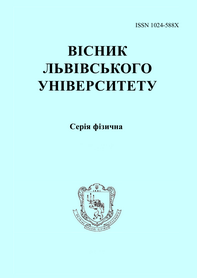DOI: https://doi.org/10.30970/vph.56.2019.3
The dependence of photoluminescence spectra of CdS QDs on stoichiometry
K.A. Verheles, V.A. Smyntyna, V.M. Skobeeva, N.V. Malushin

| Visnyk of the Lviv University. Series Physics
56 (2019) ñ. 3-10
DOI: https://doi.org/10.30970/vph.56.2019.3 The dependence of photoluminescence spectra of CdS QDs on stoichiometryK.A. Verheles, V.A. Smyntyna, V.M. Skobeeva, N.V. Malushin |  |
The influence of the ratio of the initial Cd(NO3)2 and Na2S components on the luminescence spectra of the quantum dots (QD) of CdS was studied. Analysis of the absorption spectra revealed that with increasing sulfur, which was introduced into the solution, the size of nanoparticles increased. Also, with increasing sulfur, a decrease in the size variation is observed, which can be determined from the half width of the differentiated absorption spectra. It is shown that the luminescence spectrum of cadmium sulfide nanocrystals (NC) depends on the concentration of cadmium and sulfur ions in solution. The luminescence spectra were approximated by Gaussian curves, as a result of which three emission bands were detected in CdS QDs obtained at different cadmium to sulfur ratios. With an increase in cadmium ions in solution, where the amount of introduced sulfur is not large, a short-wavelength band \lambda = 460\textdiv 470 nm appears in the luminescence spectra. Also, when the Cd(NO3)2 / Na2S molar concentration ratio is 2/1, the shortwave band has the highest intensity. A long-wavelength band appears in QD with an excess of sulfur (\lambda = 651\textdiv 720 nm) and may be associated with cadmium vacancies. In the photoluminescence spectra of nanocrystals, the luminescence band in the region (\lambda = 539\textdiv 610 nm) is also recorded; this band may be due to an associative defect associated with cadmium and sulfur vacancies. It was found that in the cadmium sulfide quantum dots during the growth process, defects are created, as is the cause of the long-wave luminescence spectrum and the ratio of the intensities of the luminescence bands depends on the stoichiometric composition of the surface. The effect of cadmium and sulfur concentrations on the size and dispersion of the size of CdS quantum dots has been established.